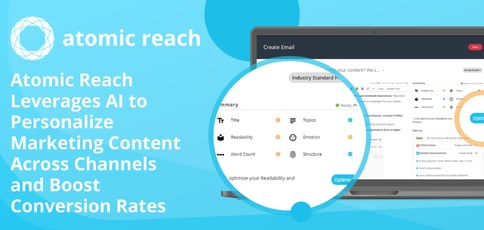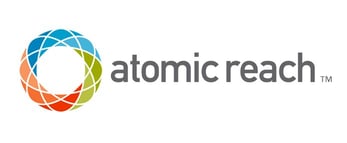
TL; DR: Atomic Reach leverages AI to help businesses produce high-quality, personalized marketing copy through its content intelligence platform. The result is better-performing content that caters to audience preferences, drives engagement, and maximizes conversions. The platform also saves time on content creation while ensuring consistent quality and brand voice across channels. Now, Atomic Reach is focused on more granular personalization and making it easier for its clients — including large enterprises — to integrate with existing workflows.
Marketing content has become vital to converting online sales. A recent study revealed that 69% of shoppers would leave a website if it contains inadequate or incomplete information about a product. That includes related content, such as videos and reviews, aggregated in — or near — the product description. Insufficient information was even more likely to make shoppers leave a page than lack of familiarity with the brand — which was the least important reason cited in the study.
The takeaway is that smart product descriptions can convert shoppers into buyers, and Atomic Reach helps businesses target their content more effectively. Its platform leverages AI to help marketing teams quickly optimize — and personalize — their content. The improved copy helps drive engagement by matching the audience’s reading preferences, which ultimately results in higher conversion rates.

The Atomic Reach intelligent content platform helps businesses create more compelling marketing content.
And it’s not only product descriptions that must be tailored. Marketers are searching for the best way to serve every type of content to their market segments, said Paul Roscoe, Vice President of Business Development and Strategic Partnerships for Atomic Reach. And they need to base that content on what their customers want today, and how they’ve engaged with the business in the past.
“Marketers also want to ensure that the content is relevant, on a channel the customer prefers, and personalized in a way that provides value,” said Paul.
Atomic Reach’s AI-based platform saves time in content creation because it removes the need for multiple drafts and review cycles by suggesting improvements in real time. It also ensures consistent quality and brand voice across channels — including blogs, marketing emails, online ads, product descriptions, and landing pages.
The company’s latest efforts focus on developing more granular personalized content, with greater readability and emotional tone. That makes it more relatable for consumers and easier for businesses to integrate into their existing workflows — especially cloud and marketing platforms. And as Atomic Reach continues to grow, it is expanding its focus to bring AI content marketing capabilities to enterprise clients.
Automatically Targeting Customers with Relevant Content
Personalizing customer communications — by understanding information about an individual — is a significant thrust in content marketing today. According to one report, 88% of marketers who responded said the main driver for that is to deliver a better customer experience. Other reasons included increasing customer loyalty, generating measurable ROI, and gaining more leads.
According to Paul, customers enjoy personalized communication — as long as the content is relevant and provides value. If it’s not, they may get a little concerned about privacy in some cases, such as an email addressed to them by name.
“They may start to think, ‘Why are you collecting enough information to know who I am and my name, but not enough to provide something relevant to me?’” Paul said.
The Atomic Reach content intelligence platform ensures that the language used in a marketer’s content is on point, on topic, and relevant to the particular end user. It also analyzes content for readability, perspective, and emotional tone and automatically provides suggestions for improvements. These areas are especially important when looking at different market segments and customer personas based on demographics, including gender or income level.
For example, when Atomic Reach helped a sporting goods site optimize product descriptions for golf clubs, it found that male shoppers had different preferences for those descriptions than did female shoppers for similar products. The AI analyzed descriptions and identified language patterns and emotional attributes that linked with customer purchase behaviors, and created personalized profiles for both product categories.
Analyzing historical data revealed that male shoppers preferred more complex or technical language with a more exciting emotional tone. After four weeks of using the optimized product descriptions for each group, sales saw a 94% average increase in unique purchases and revenue grew by 7.29%.
Another Atomic Reach retail customer sells within its own ecommerce store and also within the Amazon Marketplace and Walmart’s online marketplace. But income levels and average shopping cart values differ widely among those channels.
“As we’ve implemented our solution and started to optimize content, we see the need to speak to different market segments in different ways to have your content resonate,” Paul said. “We can use any data you have on your customers to optimize content, based on how those customers have interacted with you in the past.”
Upcoming Integrations will Bring the Platform to More Channels
Adding new technology to a marketing department with established systems and existing workflows can often upset operations. Ideally, new tools will integrate with current marketing stacks, and without disrupting operational flow or adding time to the process.
Atomic Reach makes that possible by taking an API-based approach. Its platform also integrates seamlessly with many popular marketing applications.
“We want to fit into the existing workflow and ensure that we’re not creating more work or additional steps,” Paul said. “So we work with a growing universe of content management systems, email, ecommerce, and marketing automation platforms. We’re meeting marketers where they work.”

Atomic Reach integrates with many popular content marketing platforms so it doesn’t disrupt business workflows.
Current integrations include HubSpot, WordPress, Marketo, Google Ads, MailChimp, Google Analytics, and Google Docs. The company is also in the process of rolling out additional integrations into the Oracle Marketing Cloud, the Salesforce Marketing Cloud, and the broader Adobe Marketing Cloud, said Paul.
Further planned integrations include Amazon, Shopify, BigCommerce, Facebook, and LinkedIn, among many others with big names in the content marketing industry.
And Atomic Reach pursues many of the newer integrations by targeting the most significant marketing platforms in use today to satisfy even the largest enterprise clients.
Expanding its Focus by Onboarding Enterprise Clients
High-quality targeted marketing content is vital for businesses of any size, which is why Atomic Reach has scaled its AI solutions to help large enterprises. Atomic Reach begins by running a proof-of-concept that takes between 30 and 45 days, depending on the scope, said Paul.
Then, the company parses the client’s digital content and engagement metrics and completes an initial analysis using its AI algorithms. After sharing the insights it has gleaned from that process, Atomic Reach shows the company how optimized content can help boost engagement and conversions.

Paul Roscoe, Vice President of Business Development and Strategic Partnerships for Atomic Reach, spoke with us about the platform’s effectiveness.
Some enterprise projects are much broader in scope, so the proof-of-concept may take longer, but overall the onboarding process is fast, said Paul. Like others within an enterprise organization, marketers typically have budgets and timelines, so when they’re evaluating new technologies, it’s all about time and ROI.
“They’re asking, ‘How quickly am I going to be able to realize value from this new technology?’” Paul said. “We’re focused on streamlining that process and making that time frame as short as possible.”
Atomic Reach plans to accomplish that by increasing the automation of content production. According to Paul, the company wants the writing process to be fully automated. That’s why it is researching ways to provide topics, keywords, and basic parameters for a piece of content and having AI create the initial draft using natural language generation.
“This is something we’re pretty excited about, and something that we think we will accomplish in the future,” Paul said.
HostingAdvice.com is a free online resource that offers valuable content and comparison services to users. To keep this resource 100% free, we receive compensation from many of the offers listed on the site. Along with key review factors, this compensation may impact how and where products appear across the site (including, for example, the order in which they appear). HostingAdvice.com does not include the entire universe of available offers. Editorial opinions expressed on the site are strictly our own and are not provided, endorsed, or approved by advertisers.
Our site is committed to publishing independent, accurate content guided by strict editorial guidelines. Before articles and reviews are published on our site, they undergo a thorough review process performed by a team of independent editors and subject-matter experts to ensure the content’s accuracy, timeliness, and impartiality. Our editorial team is separate and independent of our site’s advertisers, and the opinions they express on our site are their own. To read more about our team members and their editorial backgrounds, please visit our site’s About page.

